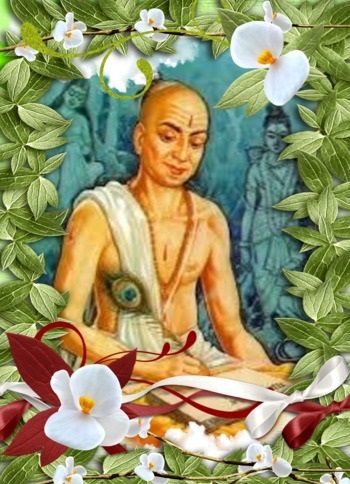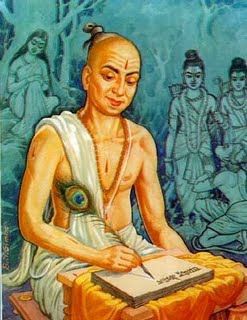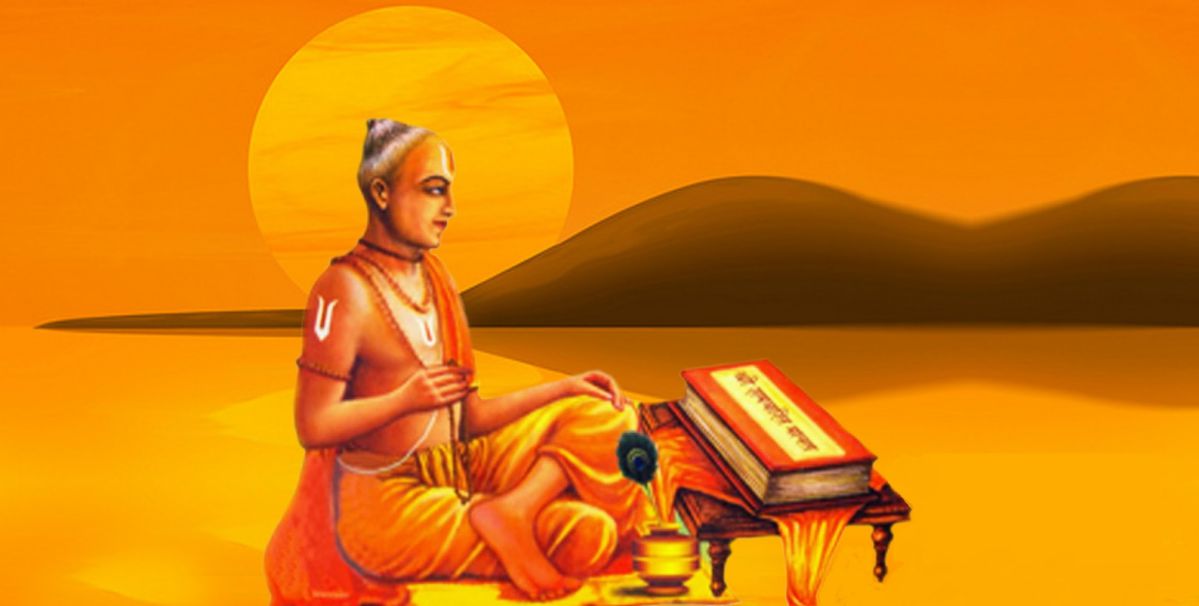No products in the cart.
Tulsi Ramayana is a very famous and great epic of North India. It tells the story of Sri Rama. It was written by Goswami Tulsidas. (Goswami means one who has renounced the world and has become a Sanyasi, that is, an ascetic.) That is why it was popularly known as Tulsi Ramayana.
Tulsidas gave it the title, ‘Ramacharitramanas’.
Valmiki, the first poet, told the story of Sri Rama in his ‘Ramayana’; after him hundreds of poets have retold it in their own way. ‘Tulasi Ramayana’ is one of the most popular and venerated Ramayana’s.
Many poets of our country were saints. They were great scholars as well as great devotees. They lived as rishis. Goswami Tulsidas too was a great scholar well versed in Vedic lore, philosophy and mythology. People say that Tulsidas, by virtue of his perfect devotion, was so fortunate as to meet Anjaneya, the renowned servant of Sri Rama. It is said Anjaneya helped him to see with his own eyes Sri Rama and Lakshman. Tulsidas declared: ‘Bhakti is the only way leading to God’s grace. Sri Rama is the Supreme God (Parabrahma). He is the ideal man. And he is the Lord of this world. His words and deeds themselves form the code of human conduct in this world.’
In his ‘Ramayana’ Tulsidas has narrated the story of Sri Rama; he has also taught the principles of right living through different characters. The lessons taught in that work are valid to this day.
The epic gives beautiful pictures of the right relation between father and children, and of the affection among brothers. It also shows how the husband and the wife, mothers-in-law and daughters-in-law, should conduct themselves. Tulsidas describes the affection of a teacher for his disciples and the respect of the disciples for their teacher. But his poem is not just a moral Piece. Tulsidas has narrated the story of Sri Rama in a moving and delightful way. As we read it we feel as if we see Rama, Sita and Lakshman before our very eyes.
The Path of Bhakti
‘ Sri Rama is the Parabrahma. He is all-powerful. He is Purushottamah (The Man Supreme). Sri Rama’s deeds, words, manners and conduct alone are the models of an ideal life. Singing hymns in His honour as his servants is the on way to attain His grace and a salvation. Knowing Him to be their master, the duty of human beings is to offer their services to Him.’ This is the sum and substance of the Bhakti cult of Tulsidas.
Sri Rama is the Parabrahma. He is all-powerful. He is Purushottamah (The Man Supreme). Sri Rama’s deeds, words, manners and conduct alone are the models of an ideal life. Singing hymns in His honour as his servants is the on way to attain His grace and a salvation. Knowing Him to be their master, the duty of human beings is to offer their services to Him.’ This is the sum and substance of the Bhakti cult of Tulsidas.
After some time Tulsidas began to think of leaving Chitrakuta. This was because he had a feeling that he would not be able to see Sri Rama there. So he went to Ayodhya, the birth place of Rama. For a long time he did ‘tapas’ (leading a very strict life, giving up all pleasures and devoting all the time to the contemplation of God) there. But even there he did not get the vision of Sri Rama. His mind was not at ease. Day by day his desire to see Sri Rama grew more and more intense.
One day it suddenly flashed to his mind that God Anjaneya grace ‘was essential for him to see Sri Rama. Yes. Anjaneya was the greatest devotee of Sri Rama. Only he could help Tulsidas see Sri Rama. So the first thing was, to see Anjaneya.
Ramacharitramanas
Tulsidas left Kashi and went again to Ayodhya. While he was in Kashi he seems to have composed two poems; ‘Janaki Mangala’ and ‘Parvati Mangala’. In Ayodhya he did rigorous tapas in, utter solitude for some time. Then he’ made up his mind to write the ‘Ramacharitramanas’. He himself saw Sri Rama, Sita and Lakshman in this epic; and he enabled the readers, too’ to see them.
Tulsidas has depicted most effectively in his ‘Ramacharitramanas‘ how by his own example Sri Rama, the God born as man, set an ideal before the people of this world. Just as Sri Rama is sketched as an ideal leader and king, Sita Devi is portrayed as a gem of ideal womanhood. She shines as a bright lamp placed on the threshold, illuminating two homes – that of her parents and that of her husband. She was dear not only to her parents but also to her servants.
At the time of sending her to her husband’s house, all the queens and their companions were sad. The very parrots in golden cages cried, “O, where is Sita?”
This is just one example to show how Tulsidas’s picture of the simplicity and goodness of Sita Devi is different from the picture portrayed by Sage Valmiki. There are some very touching episodes in the ‘Ramacharita- manasa’, which are not found in other Ramayana’s.
These delicate flowers of the poet’s imagination give forth a sweet fragrance of Bhakti.
One such episode reveals Guha’s Bhakti. He is the chieftain of the boatmen and a staunch devotee of Sri Rama.
When Sri Rama, Sita and Lakshman come to the forest Guha serves them in many ways.
The next day Guha is to ferry them across the river. Sri Rama is about to step into the boat. Then Guha behaves in a way which at first seems stange. He says to Rama, ‘My Lord, pardon me; I cannot allow you to get into the boat until I wash your feet. The mere touch of the dust of your feet turned a stone into a woman, the wife of a sage. What am I to do it my boat turns into a woman at the touch of the dust of your feet?” (Ahalya had become a stone by a curse; the divine touch of Sri Rama made her again a woman).
Tulsidas has depicted this situation very touchingly. In the words of Guha, a fine sense of humor, innocent devotion and Rama’s divinity are all reflected at the same time.
Tulsidas has also brought out Bharat’s intense love for his brother, the affection of Dasaratha for his son, the simplicity of Sumitra, Rama’s magnanimity and grace in’ his treatment of Shabari, who is considered as one of the greatest devotees of Lord Rama and Jatayu and many other such virtues.
The scholars of Tulsidas’s times thought that epics ought to be composed only in Sanskrit. Tulsidas knew that scholars would object that his epic was in Hindi, the language of the common man. But he believed that good poetry, like the sacred river Ganga, should be accessible to one and all and should reach everyone.
On the whole, Tulsidas’s ‘Ramacharitramanas’ preaches the traditional values of truth and righteousness, but presents them in greater splendor in a new context. When people had lost courage and were groping in darkness, Tulsidas’s ‘Ramacharita manasa’ appeared as a guiding light of culture; it showed them the divine figure of Sri Rama in the bright light of Bhakti.
Krishna and Rama Are One
 Gradually the number of followers of Tulsidas grew enormously. Poets like Nabhadas, Pranachand Chowhan, Hridayararn and Agradas became his disciples, too. Inspired by his preaching and ideal life they devoted themselves to the task of spreading the cult of Rama Bhakti.
Gradually the number of followers of Tulsidas grew enormously. Poets like Nabhadas, Pranachand Chowhan, Hridayararn and Agradas became his disciples, too. Inspired by his preaching and ideal life they devoted themselves to the task of spreading the cult of Rama Bhakti.
Once Tulsidas went to Mathura, the centre of Krishna’s devotees. Goswami went to the temple of Krishna at Mathura. He was greeted and welcomed warmly by the holy men there. They said to him, “Sir, we believe that you are a matchless devotee of Sri Rama. Is it true you never sing of any gods other than Sri Rama?”
Tulsidas said, “No. It is not so. In fact Sri Rama is Sri Krishna.” And then he composed on the spot a song on Sri Krishna and sang it. Though it was on Sri Krishna, the attributes were those of Sri Rama. The saints and sages gathered there were highly pleased. It is said that a miracle took place. Even as Tulsidas’s song ended the idol of Sri Krishna (with a flute in his hand) in the inner shrine appeared as the idol of Sri Rama holding a bow in his hand.
People who witnessed this sight stood amazed. They were full of praise for Tulsidas who showed that Sri Rama and Sri Krishna were one.
After this Tulsidas composed his ‘Krishna Geetavali’.
Goswami Tulsidas had visited all the holy places. He spent his last days in Kashi. It is said that in his last days he suffered from pain in the arms. Having lived a fruitful and saintly life of 136 years
Tulsidas passed away in 1680 of the Vikrama Era (i.e. 1623 A. D.) in Asighat of Kashi.
Scholars say that Goswami Tulsidas has written 37 books. But only 12 of them have survived.
Tulsidas was a great man. He suffered much hardship from his early years. He did not know the care and affection of father and mother. He was brought up by the charity of the people. Even after he became a sanyasi, difficulties did not cease. When he settled down in Kashi, many blamed him, and many made fun of him. But he was always patient and calm. Once he said, “Some say that Tulasi does bad deeds. Some call him a big cheat. Some others say that he truly is a devotee of Rama. I can bear all comments. My mind is untroubled. Whatever is to happen to Tulasi, good or bad, is in the hands of Rama.”
Kindness and courage were blended in him A Brahmin, it seems, had done something bad. So he came to Kashi to purify himself. The orthodox people kept him at a distance as an outcaste. But Tulsidas treated him as one of his own people. He knew full well that the orthodox people would be furious; he knew he would have to face severe criticism. Yet he ate the food prepared by that Brahmin.
Tulsidas was a very great scholar. He had made a profound study of Indian philosophy and literature. But his scholarship did not make him arrogant. For him meditation on Rama was more important than all other things. Whatever the difficulties one should not lose zest in life. One should always do well to others treating all as the children of God, making no distinction of caste, status or rank. This was the way he showed to others and this was how he himself lived.
Tulsidas showed the way of Bhakti. It is a good way of life even today. The characters he has sketched such as .Sri Rama, Lakshman, Bharata, Sita, Anjaneya, Vibhishana, Jatayu, Guha and Sugreeva’s are ideal figures of Hindu culture. We should rejoice that such a great poet and a saint of such high order as Goswami Tulsidas was born in this country, and lived and carried on his mission here.






